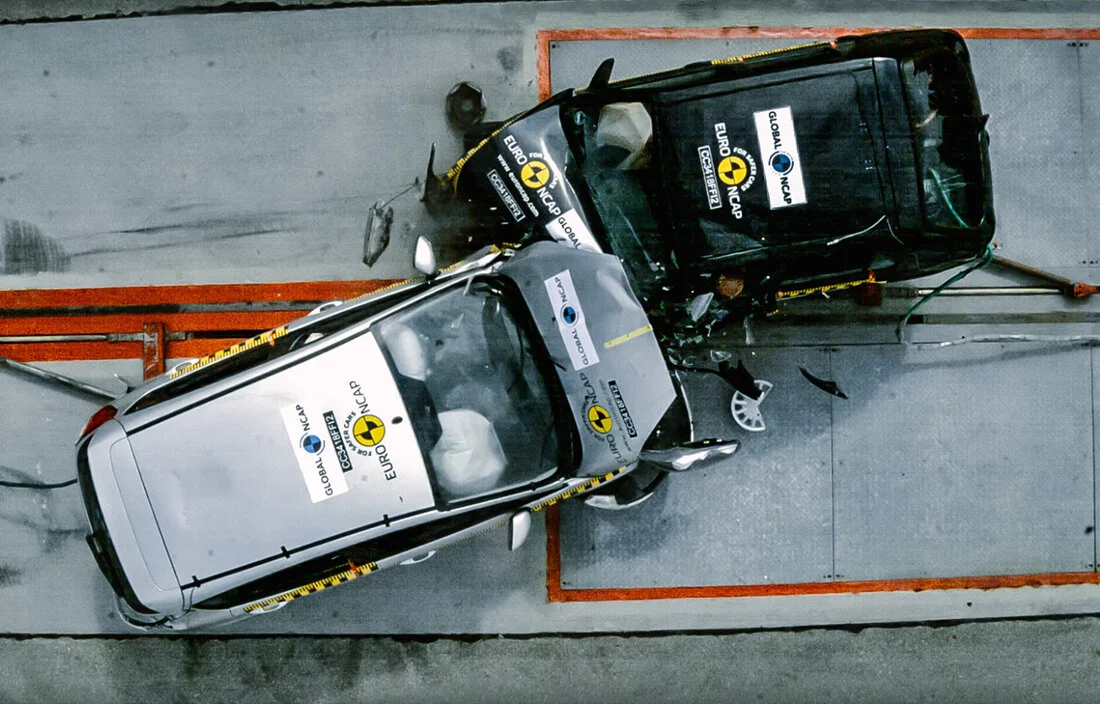Crashing Cars To Save Lives
Twenty years ago, new passenger car crash tests were mandated which have dramatically improved road safety across the European Union (EU). Applied from October 1998, front and side impact standards have cut vehicle occupant deaths in Europe by half and saved tens of thousands of lives. The same crash tests, subsequently adopted as United Nations regulations, are now the most important benchmarks for occupant safety around the world. Their adoption, despite strong opposition from the automotive industry, represents a major victory for evidence-based research and for high standards of consumer protection.
To mark the twentieth anniversary of the EU crash test legislation Global NCAP has carried out a car-to-car crash test of one of Europe’s best-selling models, the Ford Fiesta; one dating from 1998 and the other a current model, both travelling at 64 km/h. The dramatic results demonstrate the huge improvement in occupant safety that has occurred over the last twenty years. The bodyshell of the 1998 Fiesta collapses risking fatal and serious injuries to the driver and passengers. In contrast the modern Fiesta withstands the impact very well with minimum risk of life threatening injury. See film of Fiesta car-to-car crash test here: youtu.be/vFSZxlaCAOw.
Together with the crash demonstration, Global NCAP’s Secretary General, David Ward has written a special anniversary article which tells the story of the hard-fought battle to defeat opposition from the Association of European Automobile Manufacturers (ACEA) and overcome the risk of corporate capture of EU vehicle safety. Read Blog by David Ward
This success was brought about by a coalition of safety groups* persuading the European Parliament to amend the European Commission’s original proposal. Their action prevented the adoption of weak front and side impact standards favoured by ACEA and instead saw the entry into force of crash tests which research had proved were much more realistic and would save tens of thousands of lives. These forecast benefits have been shown to be valid. Overall road fatalities in the EU from over 45,000 in the mid-1990s to 25,000 and that the combination of EU crash test legislation and effect of Euro NCAP crash ratings have saved around 78,000 lives since 1997.
The article also celebrates the fact the EU’s crash test standards were subsequently adopted by the United Nation’s World Forum for Harmonisation of Vehicle Regulations – numbered Regulations 94 and 95 respectively. And now the ODB frontal impact regulation is applied in Brazil, China, India, Malaysia and in Mexico from next year. youtu.be/btlKfobnLFs This will help overcome the shocking double standards that today result in some international car companies selling new models that collapse just as catastrophically as the 1998 Ford Fiesta in our anniversary car-to-car crash demonstration.
The article concludes with five key lessons from the EU’s twenty-year success story of improved car safety. Firstly, that evidence-based research is the essential basis of effective regulation. Secondly, that the legislative process must be open and transparent to counteract the risk of corporate capture of the regulatory system. Thirdly, that best available technology and high levels of consumer protection should always be the regulators first choice as they encourage innovation and provide the greatest life-saving potential. Fourthly, that regional and global harmonisation of vehicle regulations offers economies of scale that can raise levels of safety worldwide. And finally, that independent consumer testing of the kind carried out by New Car Assessment Programmes acts as a powerful stimulus for industry to exceed legislative requirements.
David Ward concludes that “Over the next twenty years car safety will be transformed again by advanced technologies for driver assistance and greater vehicle autonomy. We will move from saving lives during a crash to avoiding the crash entirely” and warns that, “the lessons learned from legislating for EU crash test standards must not be forgotten, as they represent best practice in achieving life-saving improvements in vehicle safety. And we will need similar bold and decisive action in the decade ahead as we strive to halve road traffic deaths and serious injuries, not just in the EU, but across the world”.
* The European Transport Safety Council (ETSC), the European Consumers Organisation (BEUC), and the worldwide motoring organisation, the Federation International de l’Automobile (FIA).





